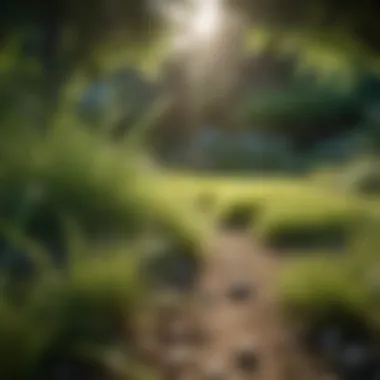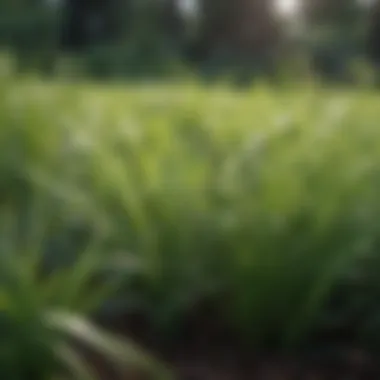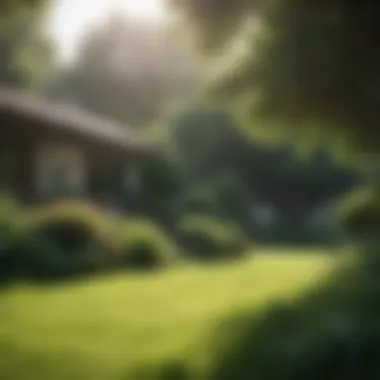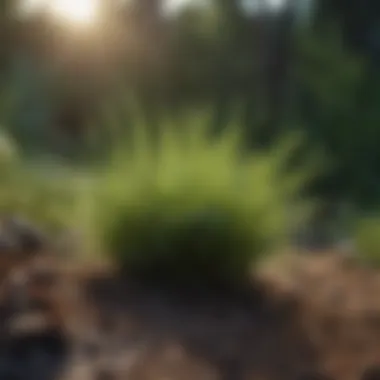Top Grass Varieties for Shaded Lawns: A Complete Guide


Intro
Growing grass in shaded areas presents unique challenges. Many homeowners find themselves frustrated as sunlight fails to reach all corners of their yards. This can lead to patchy growth, resulting in an unappealing and uneven lawn. Understanding the attributes of various grass species that thrive in low-light conditions is essential for achieving a lush, green space.
This article will delve into the best grass varieties suited for these shaded environments. We will examine their growth characteristics, maintenance requirements, and how well they perform in different climates. By the end of this guide, readers will be equipped with knowledge necessary to nurture these grasses effectively.
Key Points to Discuss
- Characteristics of shaded areas and their impact on grass growth
- Best grass species for different shade levels
- Effective strategies for planting and maintenance
- Addressing common challenges in shaded lawns
With this focus, we aim to empower readers to transform their shaded lawns into vibrant green spaces.
Understanding Shaded Areas
Understanding shaded areas is essential for anyone looking to cultivate a thriving lawn. This section paves the way for identifying the types of grass that flourish in environments where sunlight is limited. The significance of knowing about shaded areas lies in the unique challenges they pose to grass growth and the smarter use of resources like seed selection, watering, and maintenance strategies. By thoroughly grasping the elements that contribute to shading, one can make informed choices that lead to successful and healthy grass growth even in low-light situations.
Definition of Shaded Areas
Shaded areas are locations that receive limited sunlight due to various natural and artificial obstructions. These zones may not receive the full spectrum of sunlight desired by many grass species, leading to challenges in grass health and growth. Different definitions may exist based on local climates and typical shade patterns, but generally, any area that receives less than four hours of direct sunlight per day can be considered shaded.
Common Causes of Shade
The causes of shade are multifaceted, often stemming from various factors in the environment. Understanding these causes is key to addressing challenges inherent to shaded areas.
Trees and Shrubs
Trees and shrubs play a prominent role in creating shaded areas in gardens and lawns. Their height and foliage block sunlight, making it difficult for grass to receive the light it requires. This characteristic serves both advantages and disadvantages. On one hand, trees can provide a protective environment, preventing soil erosion and providing habitat for wildlife. On the other hand, the dense canopy often reduces grass vitality, leading to patchy or stunted growth. When choosing grass types for shaded areas, it's vital to assess the degree of shade created by trees and shrubs.
Structural Obstacles
Structural obstacles include fences, buildings, and other constructions that impede sunlight from reaching the ground. These elements can create complex patterns of light and shade, resulting in uneven growing conditions. While structural features might enhance aesthetic value, they can also limit options for grass growth. The shadows cast by these structures can lead to a harsher environment for potential grass species, affecting water retention and overall soil health. Solving these issues by selecting the right grass types is essential for maintaining a lush landscape.
Topography
Topography refers to the physical features of the land, including hills, slopes, and dips. The layout of the terrain can greatly influence light exposure in a garden or yard. For example, sloped areas may receive limited sunlight due to their orientation. While topography can provide unique landscape features, it might also create secluded areas that experience extended periods of shade. Being aware of the topographic variations is crucial in understanding which grass species will be best suited for each unique setting.
Overall, comprehending shaded areas, their definition, and the common causes of shade allows homeowners to navigate the challenges of growing grass effectively, ensuring that the right species are selected for optimal growth.
Challenges of Growing Grass in Shade
Growing grass in shaded areas presents a unique set of challenges that require specific strategies for successful cultivation. Understanding these challenges is essential for anyone aiming to create a vibrant lawn in less-than-ideal light conditions. The intricacies of shaded areas often influence the selection of grass types, planting methods, and maintenance routines. Identifying the factors that hinder growth can lead to more informed decisions in the gardening process.
Light Requirements
Grass in shaded areas competes with trees or structures for sunlight. Different grass species have varying light needs, with some able to thrive in partial shade while others barely tolerate it. General guidelines often suggest that grass should receive at least four hours of direct sunlight per day to grow effectively.


In addition, the intensity and quality of light vary based on the time of day and surrounding environment. For instance, northern exposure tends to offer softer light, while southern exposure can be more intense, even in shaded conditions. The key is to select grass varieties that not only tolerate but can also thrive under limited light. Understanding these requirements can make the selection process more manageable and fruitful.
Soil Quality and Drainage
The role of soil quality in growing grass under shade cannot be overstated. The texture, structure, and nutrient content of the soil contribute to the overall health of the lawn. Shady areas often suffer from poor drainage due to tree roots and competing plants, which can lead to waterlogged conditions. This, in turn, hinders grass growth and development.
Testing the soil is an advisable first step. Adjusting the pH, incorporating organic matter, and ensuring adequate drainage systems are in place becomes critical. Compacted soil should be aerated to promote root expansion and health. Therefore, addressing soil quality and drainage issues is vital to creating a thriving grass lawn, even in shadowy areas.
Pest and Disease Risks
Shaded environments can create a conducive setting for pests and diseases, further complicating the task of growing grass. The lack of sunlight often results in higher humidity levels, which can facilitate the spread of fungal infections. Brown patch disease, for instance, is one common ailment that flourishes in wet, shaded conditions.
To mitigate these risks, it is essential to adopt a proactive approach. Regular monitoring for pest populations and symptoms of disease can help catch issues before they escalate. Maintaining optimal watering practices and promoting airflow can reduce humidity around the grass, making conditions less favorable for harmful organisms. Establishing a healthy approach toward pest management is essential for sustaining growth in shaded lawns.
Types of Grass Suitable for Shaded Areas
Growing grass in shaded regions can be challenging, but selecting the right type of grass can make a significant difference. Grass species that thrive in low-light conditions offer specific benefits, such as better adaptability and resilience. Understanding the characteristics of these grasses is essential for successful growth and maintenance.
Fine Fescue Varieties
Fine fescue grasses are well-suited for shaded areas due to their tolerance for low light levels and their fine texture, which can create a lush lawn appearance even under cover. There are several varieties worth considering.
Hard Fescue
Hard fescue is a notable choice for shaded lawns. Its key characteristic is its excellent drought resistance and ability to withstand wear. Hard fescue is known for its dense growth habit, which helps it compete well against weeds. Its unique feature is its fine leaf texture, contributing to a soft feel underfoot. The advantages include lower maintenance needs and reduced watering requirements, making it an eco-friendly option. However, it may struggle in excessively wet conditions, requiring careful consideration of local climate.
Chewings Fescue
Chewings fescue stands out for its ability to thrive in partial shade. This grass type is highly regarded for its lush green color and fine leaf structure. Its key advantage is its tolerance to close mowing, which is beneficial for lawns and sports fields. Wealthy in nutrients, Chewings fescue contributes to a healthy lawn ecosystem. However, it can be prone to disease in humid climates, making awareness of local pest threats necessary.
Red Fescue
Red fescue is another fine choice for shaded areas, recognized for its exceptional shade tolerance. Its primary characteristic is its ability to spread and fill in patches, which enhances lawn density. The unique benefit of red fescue is its fine, creeping growth habit, making it excellent for blended seeding with other grasses. While it is drought-tolerant and adaptive, red fescue requires good drainage and can struggle in compacted soils, necessitating proper site preparation.
Kentucky Bluegrass
Kentucky bluegrass is a classic choice for lawns, known for its rich color and softness. It can grow in partial shade but requires more sunlight than fine fescues. Its adaptability to various soil types and its expansive root system improve its drought resistance. However, it can become dormant in drought periods and may demand more frequent maintenance to ensure its health in shaded conditions.
Perennial Ryegrass
Perennial ryegrass is often selected for its quick germination and establishment. It performs well in partial shade, making it ideal for homeowners seeking rapid ground cover. Its key characteristic is its fine, upright growth habit, providing a beautiful lawn appearance. However, it can be less tolerant of heat and drought, needing regular watering during warmer months. Mixing it with other grass types can enhance a shaded area’s resilience.
Zoysia Grass
Zoysia grass delivers impressive tolerance to heat and drought, making it suitable for both sunny and partially shaded environments. Its thick mat prevents weeds from taking hold, enhancing lawn durability. A key feature of Zoysia is its slow growth, which requires less frequent mowing. However, it can be slow to establish and may not thrive in overly shaded conditions. Pay attention to its moisture needs, especially during establishment.
In summary, selecting the appropriate grass type for shaded areas requires careful consideration of growth habits and local climatic conditions. The right choice can lead to a thriving, resilient lawn.


Planting Grass in Shaded Areas
Planting grass in shaded areas is a critical aspect of landscape management, especially for those who desire a lush green lawn despite limited sunlight. Understanding the specific challenges associated with shading allows one to implement methods tailored for successful grass growth. The approach to planting must consider various elements, such as preparation, timing, and methods, which directly affect the success of grass establishment in these conditions. Careful consideration of these factors not only ensures better growth but also sustains long-term health of the lawn.
Preparation of Site
Effective preparation of the site is paramount before planting grass in shaded areas. This means assessing the location and understanding the extent of shade, the type of soil, and how well it drains. First, clear the area of any debris, rocks, or existing grass that may hinder new growth. If present, removing microclimates formed by tree roots or dense shrubbery is also important.
Checking soil quality is another step that often demands attention. Conducting a soil test helps determine pH levels and nutrient content. Based on the findings, amendments such as lime or fertilizers might be necessary to adjust soil conditions. Moreover, addressing drainage issues by aerating the soil can significantly improve the environment for grass germination. Finally, loosening the topsoil enables better seed contact, which is helpful for successful establishment.
Choosing the Right Time for Planting
Timing is critical when it comes to planting grass in shaded areas. The best times typically fall in the early spring or early fall, depending on regional climates. Planting during these windows allows grass seeds to germinate and establish before more extreme weather conditions set in.
Understanding local climate patterns will help in selecting the right timing. In regions with milder temperatures, fall planting may offer the best chance for deep root establishment as the soil stays warm, while cooler air temperatures slow down growth. Conversely, in warmer areas, early spring planting allows for the benefit of increased sunlight as days grow longer, though some care must be taken to avoid drought in the heat of summer.
Seeding Methods
Broadcast Seeding
Broadcast seeding involves scattering seeds over a designated area with a tool or by hand. This method is valued for its simplicity and effectiveness in creating a wide coverage with relatively little effort. The key characteristic of broadcast seeding is its suitability for larger areas where uniformity is desired.
This method is particularly beneficial for shaded lawns, where a gentle coverage allows for finer seeds to settle into the soil mixes with other organic materials. However, a drawback to be mindful of is uneven seed distribution, which can lead to patchy growth. It is essential to follow up with light raking to ensure seeds make contact with the soil, enhancing germination rates.
Hydroseeding
Hydroseeding is a more modern approach involving a mixture of seed, mulch, water, and fertilizers, applied using specialized equipment. This method delivers a considerable advantage through its ability to cover uneven terrains and slopes effectively, making it a popular choice for areas prone to erosion or challenging to plant. The unique feature of hydroseeding is its quick application, which facilitates large-scale sowing without extensive labor.
While hydroseeding offers advantages in rapid establishment and moisture retention, it can come at a higher cost than traditional seeding methods. Furthermore, it demands particular technical knowledge and equipment, making it less accessible to the average homeowner. Thus, assessing the context of your lawn and budget is necessary to determine if hydroseeding aligns with your goals.
In summary, successful planting in shaded areas hinges on thorough site preparation, timely actions, and the appropriate seeding method. Each of these elements contributes significantly to the ultimate success of creating a green sanctuary, even in low-light environments.
Maintenance of Grass in Shade
Maintenance is a key factor in establishing a healthy lawn in shaded areas. Proper care ensures that grass remains vigorous and can effectively compete with the challenges posed by low light and potential moisture issues. Maintaining grass in shaded regions involves several practices tailored to meet its unique needs. This approach helps maintain aesthetics and promotes overall lawn health, which can ultimately influence the local ecosystem.
Watering Practices
Watering plays an essential role in the health of grass in shaded areas. Insufficient water can lead to stress and hinder growth, whereas overwatering can cause issues like root rot. Therefore, it is crucial to find the right balance. Focus on the following elements when watering:
- Frequency: Lawns in shaded regions often retain moisture longer than those in full sun. Watering once or twice a week is generally sufficient. Monitor soil moisture to avoid excess.
- Timing: Early mornings are optimal for watering, as this reduces evaporation and allows grass to absorb moisture efficiently.
- Method: Utilize a soaker hose or drip irrigation system. This method delivers water directly to the root zone, which is especially beneficial in shaded areas where grass may require more targeted watering.
Fertilization Guidelines
Fertilization is integral in supporting grass health, especially in shaded areas where nutrient competition can be high. A few key considerations include:


- Soil Testing: Conduct a soil test to assess nutrient levels and pH. This information helps in selecting the right fertilizer formulation.
- Type of Fertilizer: Use a slow-release fertilizer that offers a steady supply of nutrients over time, reducing the risk of nutrient leaching out before it can be absorbed.
- Application Timing: Fertilization should occur in early spring and again in late summer, aligning with the growth cycles of grass species. Applying too late in fall can encourage growth that is vulnerable to winter damage.
Mowing Techniques
Mowing is often overlooked in shaded lawn care. However, it is vital for the aesthetic and health of the grass. Here are some effective mowing techniques:
- Mowing Height: Keep mower blades set higher when cutting grass in shaded areas. A height of three to four inches allows for greater leaf surface area, which can better capture sunlight as it becomes available.
- Frequency: Regular mowing encourages denser growth, which helps shade out weeds. Mow when grass reaches about one-third taller than the desired height.
- Blade Sharpness: Use sharp mower blades to ensure clean cuts. Dull blades tear the grass, making it more susceptible to diseases and pests.
Maintaining grass in shaded areas requires a thoughtful approach to watering, fertilization, and mowing practices. By prioritizing these essentials, a lush, resilient lawn can thrive even in challenging conditions.
Monitoring and Troubleshooting
Understanding how to monitor the growth conditions and troubleshoot any issues in shaded areas is essential for maintaining a lush lawn. This process allows you to understand what your grass needs to thrive and how to adapt your practices effectively. Regular monitoring helps identify problems early, preventing minor issues from becoming major setbacks. This section focuses on two key aspects: identifying growth issues and addressing common pests and diseases.
Identifying Growth Issues
Recognizing growth problems in shaded grass areas requires keen observation. The signs can vary, but common indicators include yellowing leaves, thin patches, or slow growth. This can stem from inadequate light, poor soil drainage, or insufficient nutrients. Monitoring growth patterns and soil health will provide insights into underlying problems. A soil test may help determine pH levels and nutrient deficiencies.
Maintaining proper watering practices is also crucial. Grass in shaded areas can sometimes require less water due to lower evaporation rates. However, too much moisture can lead to issues, while too little can stress the grass. Assessing the watering frequency and volume will help identify if adjustments are necessary.
Common Pests and Diseases
Brown Patch
Brown Patch is a common fungal disease affecting grass. The indicators are often circular patches of brown or dead grass, usually appearing when the temperature is warm and humidity is high. This fungal infection thrives in dense shade, which may make it a significant concern for shaded grass areas.
The key characteristic of Brown Patch is its rapid spread in suitable conditions of nitrogen-rich soils combined with high humidity. For this reason, it is important to avoid over-fertilization during warm and wet weather. One unique feature of Brown Patch is it usually appears suddenly but can cause long-term damage if not addressed on time. Recognizing the signs early can prevent widespread damage and help maintain a healthier lawn.
Fungal Infections
Fungal infections encompass a variety of diseases beyond especially Brown Patch. These can occur due to poor air circulation, excessive moisture, and other factors common in shaded environments. The key characteristic of these infections is their tendency to cause localized dying of grass blades.
Like Brown Patch, other fungal infections can weaken grass roots, leading to further deterioration over time. Their unique feature often includes a specific cycle of spore germination that is influenced by environmental factors, such as temperature and humidity. It is essential to integrate preventive measures like proper lawn care techniques to minimize the likelihood of these infections. By being vigilant and proactive, one can maintain a healthier shade lawn with easier troubleshooting and monitoring practices.
Regular monitoring can help you catch problems early, allowing for timely interventions and healthier growth overall.
Final Considerations
Understanding the nuances of growing grass in shaded areas is essential for anyone pursuing a lush, aesthetically pleasing lawn. This section consolidates the vital aspects of long-term grass care and strategies to promote healthy, vigorous growth.
Long-Term Care Strategies
Successful maintenance of grass in shaded environments requires a thoughtful approach. Regular assessments of soil health and nutrient levels are needed. Focusing on the following elements can significantly enhance the longevity of your lawn:
- Soil Testing: Conduct soil tests every few years to determine pH levels and nutrient availability. This helps in adjusting fertilization strategies effectively.
- Fertilization Schedule: Apply a slow-release fertilizer that is suitable for shade-loving grass types. This supports ongoing growth without risking damage to fragile root systems.
- Aeration: Aerating the lawn helps improve air circulation and enhances water penetration. This step is usually skipped in shaded areas, but it can make a considerable difference.
- Dethatching: Removing thatch build-up is crucial to ensure nutrients and water reach the roots. Slow-growing grasses in shady spots are more susceptible to thatch.
- Monitoring Watering: Adjust your watering routine during various seasons. While shaded areas may require less water, it’s important to make sure moisture is adequate for the grass type you’ve selected.
Encouraging Healthy Growth
Promoting robust growth in shaded areas is a continuous endeavor. Here are practical strategies to enhance resilience and visual appeal:
- Choose the Right Grass: Select species specifically suited for shade. Readily available options include fine fescue varieties, which adapt well to low light.
- Proper Mowing Techniques: Keep mowing heights at a higher setting. Taller grass retains moisture and develops deeper roots, which is beneficial in shade.
- Pest Management: Stay vigilant for common pests and diseases that could thrive in less sunlight. Implement preventative measures to keep your lawn healthy.
- Seasonal Monitoring: Observe your lawn throughout the changing seasons. Early detection of issues such as browning or thinning patches allows for timely interventions.
Remember, maintaining a lawn in shaded areas is not just about initial planting. Long-term care strategies and ongoing vigilance play critical roles in achieving a lush, green space.







